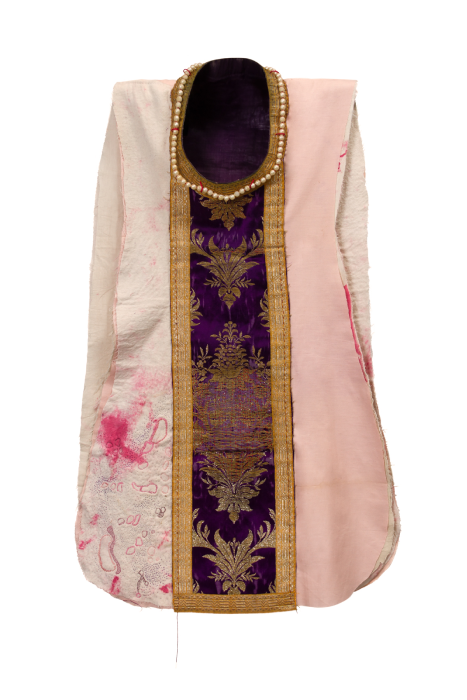This work is a declaration of feelings towards religions, because all of them, to a greater or lesser extent, feel they have rights over the female body. They tell us how to dress it, how to cover it, how to move it, how to adorn it… That is why I thought it was the right moment to use a priestly chasuble from the Catholic Church that I had been treasuring for a long time and that belonged to my family. For the Church the chasuble has a very particular meaning, it serves to cover sins and, as it rests on the shoulders, it represents submission to God.
I worked whole days mending, sewing, embroidering, it seemed to me that it was the best way to relate to these vestments and their halo of mystery and power. Spending days in contact, in a silent conversation with these fabrics, caressing them, sewing them, made me get closer to them and begin to feel them familiar. I repaired rips in the fabric that I imagine luxurious in its moment of splendor, and I remade the piece with other fabrics that are humbler, older, degraded. I obsessively embroidered an image inspired by the female mammary gland, from a 1951 Medical Histology book. The theme of rethinking the feminine is recurrent in my work, and one of the symbols I use is the female breast, present in most of my works.
I also threaded pearls forming a necklace, which I covered with latex, an organic material that undergoes transformations. The feminine and the suffering faced with the impossibility of showing oneself and being totally free.
How to tell a story that has left scars in the souls of countless women? For this I had the need to do it with my own language, using my precious materials, my colors, my instruments. By deconstructing this piece in order to rebuild it, to mend it, I felt that I was somehow trying to recompose the damage done to their spirits. I tried to transform the meaning of this clothing so that these layers of fabric become cover and shelter.
This work represents religion, with the weight of its tradition and hierarchy, and, for me, it added the responsibility of having been worn by a great-uncle. The symbolic burden added to the emotional burden. Therefore, I proposed not only to be a critique and to make visible this theme, historical and so current at the same time, but also to make possible the evolution of its meaning in a work that would add the feminine in its new configuration.
In this way the chasuble used and created for public ceremonies in liturgical acts, became something as intimate as a scapular. The scapular is a sign of devotion and protection as it is worn covering the chest and back.
The superimposition of fabrics, chosen and lovingly crafted, gives it a thickness and a weight that is both reminder and protection.
You will not enjoy your body, 2022
Priestly chasuble belonged to my family, different antique cotton fabrics, embroidery and sewing threads, old lead hem weight tape from antique dresses, crystal beads, latex, acrylic paint, silver.
Photo credits: Patricia Bova Zuccarino
“You shall not adorn your body”, 2022
Necklace made of crystal beads, thread, latex, silver
Photo credits: Patricia Bova Zuccarino




